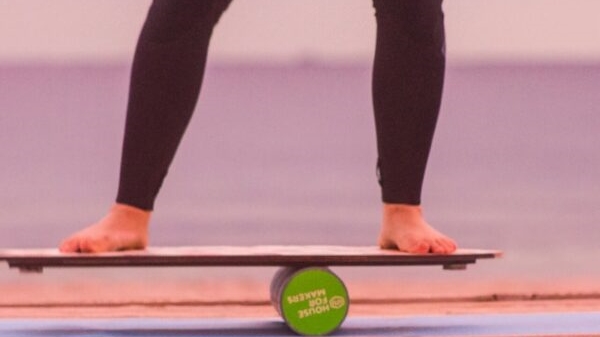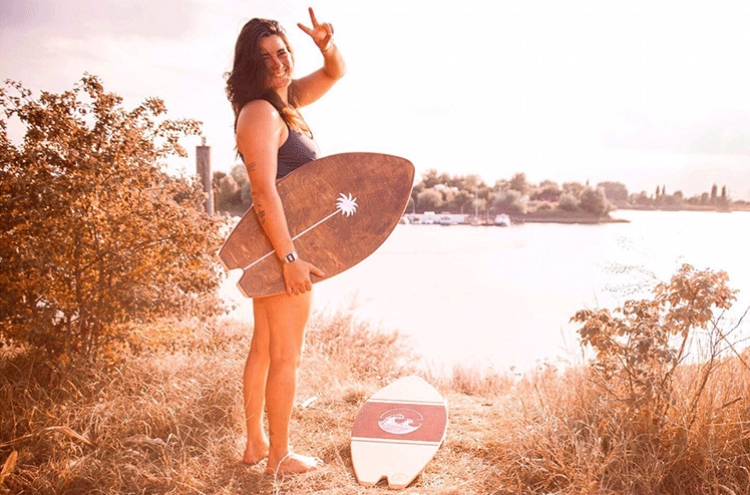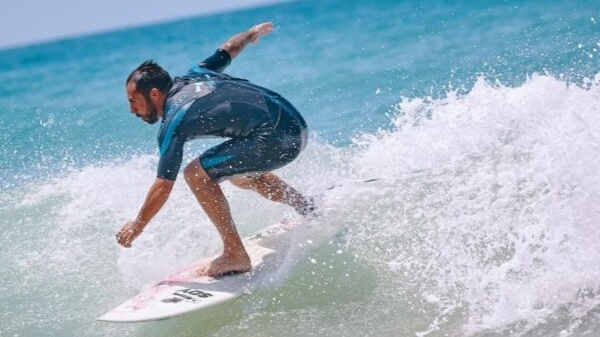
Balancing Board Safety Tips: Protecting Yourself During Workouts
Balancing boards provide an effective full-body workout, but the unstable surface can also lead to falls and injuries if proper precautions aren’t taken. By following

A balancing board, also known as a wobble board, balance board, or rocker board, is a tool used for balance, coordination, and proprioceptive training. It consists of a platform (usually made of wood or plastic) that rests on a rounded or hemispherical base, making it unstable and requiring the user to constantly adjust their body position to maintain balance on the board.
Recently, balancing boards have become a popular addition to fitness routines as people discover their many benefits for improving balance, strengthening the core and lower body, enhancing reflexes, and more.
In this blog post, we’ll take a comprehensive look at balancing boards – what they are, the different types available, their benefits for fitness, exercises to do on them, and tips for getting started with using one in your workouts.
Read on to learn why you should consider incorporating a balancing board into your regular fitness regimen.

A balancing board is a round, square, or rectangular platform balanced on top of a ball, roller, or rounded fulcrum point. This creates an unstable surface that requires constant micro-adjustments to maintain balance and stay centered on the board. The instability forces you to engage various muscles in the core and lower body in order to remain upright and avoid falling off the sides.
Balancing boards are also known as wobble boards, rocker boards, or balance boards. They come in a few different styles:
Rocker boards, also called tilt boards, have a curved or arched base that allows you to rock side-to-side or front-to-back. The instability comes from the curved shape of the base rather than a ball or fulcrum. These boards tilt up to about 15-30 degrees in each direction.
Roller boards, also known as cylinder boards, have a cylinder made of plastic or wood under the platform that rolls as you tilt the board. This creates instability in every direction and forces more dynamic balance reactions as the roller shifts beneath your feet.
These boards have a fully rounded or hemispherical base made of wood, plastic, or rubber that sits on the ground. The base allows tilting and rocking in all directions, like standing on top of a ball. The smaller the point of contact, the more difficult it is to balance.
Some boards have multiple contact points on the bottom which enable rocking side-to-side as well as tilting forward and backward. Having 2-4 contacts allows a greater range of motion to amp up the balance challenge.
Inflatable balance boards provide an extra unstable but cushioned surface. They can be deflated for easy storage and transport.
An Indo Board has a wooden deck resting on a cylindrical roller with tracks on each side to allow the deck to tilt side-to-side while also rolling forward and backward.
There are also larger balancing boards designed for use during exercise classes and physical therapy, with anti-slip deck surfaces and support bars.
Adding a balancing board to your regular workouts provides a slew of physical and mental benefits:
Balancing on an unstable surface trains your body’s neuromuscular systems to constantly adjust and stabilize, improving overall coordination and balance control. With regular use, you’ll notice better stability and poise not just on the board, but in everyday life activities.
To stay balanced on the board as you tilt and rock, you have to continually engage your core abdominal and back muscles. The instability forces you to keep these muscles contracted and works them harder than regular core exercises.
Your leg muscles, especially your calves, quadriceps, hamstrings, and inner thighs, have to constantly fire and adjust as you tilt the board and shift your weight. This engages your entire lower body musculature to keep you centered.
Proprioception refers to your body’s awareness of its position in space and ability to respond to changes in equilibrium. The balancing board improves this spatial sense and neural connections through the constant postural adjustments required.
As the board tilts and rocks, your body has to quickly react and adjust in response to keep your balance. Regular practice enhances reflexes, motor control, and your overall reaction time.
Your ankles provide the crucial foundation for balance, taking on more pressure and engaging more muscles to stabilize as you balance on the board. This improves strength, flexibility, and stabilization around the entire ankle joint.
Balancing on an unstable surface requires considerable muscular effort and physical exertion from your core and lower body. A 30-minute session can burn over 300 calories, making it a great metabolic boost for weight loss programs.
Better balance, stability, proprioception, and ankle strength make you less prone to falls, ankle twists, and other injuries. It also improves joint integrity around the ankles, knees, and hips for injury prevention.
Balancing boards are commonly used in physical therapy and sports medicine clinics to help patients retrain stability and balance after an injury, accident, or surgery. They gently reengage the neuromuscular system.
Maintaining proper upright posture and alignment of the back while balancing strengthens the postural muscles along the spine. This can improve poor posture over time.
Balancing on a board requires intense focus, concentration, and coordination. This mind-body connection keeps you mentally engaged and can reduce stress.
Balancing drills provide a fun, low-impact way to liven up mundane workouts. The instability challenges your abilities in each session in an engaging way.

There are endless ways to incorporate a balancing board into your fitness routines. Here are some of the most effective balancing board exercises to try:
Stand on one leg in the center of the board and maintain balance. Switch legs and repeat. Hold for 30-60 seconds per side. Engages the lower body.
Place one knee on the center of the board, maintaining balance on the other leg with your toes on the floor. Hold 30-60 seconds then switch sides. Tones glutes and thighs.
Stand with feet hip-width on the board. Slowly lift one leg a few inches off the surface, keeping your balance on the standing leg. Lower leg and switch sides. Repeat for 10 reps for each leg.
Stand with feet hip-width on the board. Slowly lower into a squat, stabilizing your body to keep the board steady. Return to standing. Do 2-3 sets of 10-15 reps. Hits quads, glutes, and core.
5. Lunges
Step one foot forward into a lunge, stabilizing your balance on the board. Bring feet together, then lunge on the opposite side. Continue alternating legs for 10 lunges per side.
Place hands wider than shoulder-width on the board. Keeping the board steady, lower down into a push-up. Repeat for 10-15 reps. Works shoulders, arms, and core.
Place forearms on the center of the board, balancing your body in a straight line. Engage core and glutes to hold for 30-60 seconds. Works full core stability.
In plank position with hands on board, bring one knee towards the chest, return it back, then quickly alternate knees for a mountain climber motion. Go for 20-30 seconds. Gets heart rate up.
Lie face up with heels on the center of the board. Bridge your hips up and curl your heels towards your glutes. Lower back down with control. Repeat for 10-12 reps.
Stand on one leg with the other hovering off the floor. Slowly lower your upper body towards the elevated leg for a twisting crunch. Return to balance. Switch sides. Hits oblique.
Start in a push-up position with your hands on the board. Raise your hips up while keeping your legs straight and balancing on your toes. Slowly lower back to the starting push-up position. Do 10-12 pikes.
Assume a plank position with one hand on the board at a time. Lift the free hand to tap the opposite shoulder then return to plank. Alternate sides for 10 taps per shoulder.
Step one foot onto the center of the board, transfer weight, and then bring the second foot to meet it. Step first foot forward, repeating to “walk” for 30 seconds.

If you’re new to balancing boards, keep these beginner tips in mind:
Adding a balancing board to your regular home workouts provides a fun, challenging way to improve balance, core strength, stability, lower body fitness, proprioception, reflexes, and more. Their instability forces you to engage muscles to stay balanced while performing bodyweight exercises.
Start slowly, engage your core, and work up to more advanced exercises and longer durations for greater benefits. Balancing boards make a worthwhile addition to nearly any fitness routine.
Give one a try to take your workouts up a notch!


Balancing boards provide an effective full-body workout, but the unstable surface can also lead to falls and injuries if proper precautions aren’t taken. By following

So you’ve mastered the basics of balancing on a rocker or wobbleboard. You can tilt and pivot with ease. Now you’re ready to take your

Store-bought balancing boards can be expensive, costing anywhere from $50 to over $200. But with some simple tools and materials, you can make your own

Balancing board training has become a popular way to challenge your coordination and engage those all-important core muscles. Unlike stable machines at the gym, balancing

Balancing boards provide an effective full-body workout, but the unstable surface can also lead to falls and injuries if proper precautions aren’t taken. By following

So you’ve mastered the basics of balancing on a rocker or wobbleboard. You can tilt and pivot with ease. Now you’re ready to take your

Store-bought balancing boards can be expensive, costing anywhere from $50 to over $200. But with some simple tools and materials, you can make your own

Balancing board training has become a popular way to challenge your coordination and engage those all-important core muscles. Unlike stable machines at the gym, balancing
Copyright © 2024 equistablebalancingboard. All Rights Reserved.